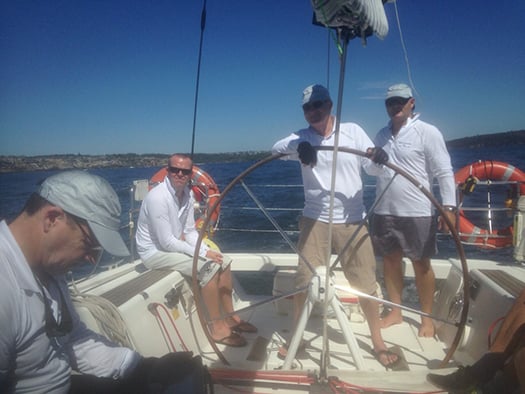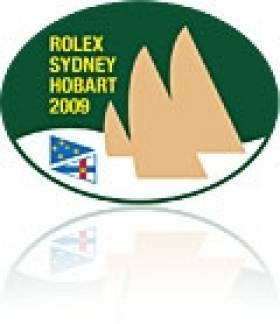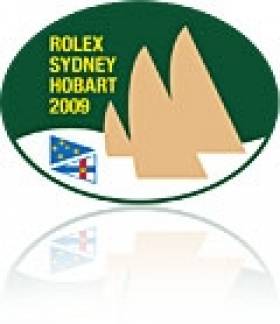Displaying items by tag: Alexander Rumball
11th Place Finish For Ireland's Sydney–Hobart Crew
#rshyr – Ireland's Breakthrough crew led by Barry Hurley has recovered from a lowly 25th place yesterday to finish 11th on IRC overall and seventh in class on day four of Australia's classic Sydney–Hobart race where the overall winner could still be at sea.
Only two hours before the finish the official tracker gave Breakthrough's position in the top ten overall but Constitution Dock, Hobart is buzzing with activity after a stream of boats crossed the finish line throughout Day 4 making any final overall result some time away yet.
Crossing the Tasmanian finish line in Hurley's third succesive race, the Cork Harbour sailor eclipsed last year's result of 27th overall but was a place behind the sixth place in IRC Division 3 achieved in 2013. It was a terrfic recovery over the past 24 hours when Breakthrough had slumped to 27th. Provisional race rankings here
In a race of snakes and ladders, the Irish crewed boat was only an estimated two hours off the overall handicap lead at the halfway stage of the 635–miler. In a fantastic opening peformance the New South Wales entry from Jonathan Stone and Mathew Vadas was as high as third place in the 109–boat fleet.
But after passing Gabo Island, things took a so far unexplained turn for the worse. The First 40 nose–dived down the rankings sinking at one stage yesterday to 27th overall on IRC overall with just 200 miles to the Tasmanian finish line.
Battling strong winds in the Bass Straits to recover some 16 places and seventh in division 3 was never going to be an easy proposition.
The drop in performance – an estimated 1.5 knots off the pace all day yesterday – prompted some of Breakthrough's shore crew to speculate that a torn spinnaker might be to blame. Others said the easterly course chosen by Breakthrough might have contributed to a slower wind angle.
But whatever the reason, the Hurely crew dug deep in the closing stages to haul back in near small boat rivals and take the best result to date in what has been an intriguing and record breaking 70th edition of the Australian classic.
Before the race started Hurley wrote on Afloat.ie 'Being one of the smaller boats at just 40ft, our position in the overall standings will be somewhat a result of the weather patterns during that particular week, whereas our placing within our class will be a true measure of success'. How right he was.

The Breakthrough crew depart Sydney
By 17:00 AEDT, 39 yachts had completed the 628-nm race, as the docks filled with tales from another dramatic contest. Of the 117 starters, 65 yachts are still sailing and a further 13 officially retired, unable to complete the course.
Veteran victory?
Current forecasts have four veteran yachts – Love & War, Quickpoint Azzurro, Wild Rose and the fleet's smallest and oldest boat Maluka of Kermandie – all in contention for overall victory. All three boats represent vast contrasts to the sleek, carbon fibre-built 100-foot Maxis which dominated the race for line honours.
Simon Kurts' Love & War is a three-time winner of the race (1974, 1978, 2006). The boat, built over forty years ago, needs to arrive in Hobart before midnight this evening to retain any chance of claiming an unprecedented fourth Tattersall's Cup. This wooden classic won in two contrasting eras of ocean racing underlining the boat's durability and the true spirit of the Rolex Sydney Hobart: any crew stands a chance of victory provided they demonstrate true teamwork, tactical nous and an intrepid spirit. Love & War, featuring veteran navigator Lindsay May competing in the race for a staggering 41st time, is currently approximately 40-nm from the finish.
Roger Hickman's Farr 43 Wild Rose is a mere 29 years old and pushing hard for that elusive first Tattersall's Cup. In poignant synergy, Wild Rose was once owned by Wild Oats XI's Bob Oatley, whose crew yesterday claimed a record-breaking eighth line honours victory. Wild Rose has already produced a stern, resilient performance, overcoming adversity on her journey south. "We had a massive broach in 30 knots this morning with the spinnaker up," Jenifer Wells, the crew's navigator reported. "We laid her over a couple of times, broke the steering cable and it was looking very dicey. "We got out the emergency tiller and pulled the kite down, repaired the cable and we were back racing in 12 minutes."
Another wooden classic is Maluka of Kermandie, a gaff-rigged huon pine beauty. Owned by one of the race's colourful characters, Sean Langman, the 30-footer still lies some 122-nm from the finish line.
Currently leading on handicap though is Shane Kearns' Sparkman & Stephens 34 Quickpoint Azzurro 108-nm from Hobart.
Happy Hobart
The crews arriving in Hobart this afternoon carried the look of seasoned offshore racers: tired, proud, red-eyed, salty and wind-swept.
"The race is always very different and always extremely challenging and this one was special as it was my wife's first Rolex Sydney Hobart," explained Philip Coombs, owner of the 42-ft Simply Fun, whose amateur crew performed miracles to even make the start line. "The team I have are brilliant. Three days before we were due to leave for Sydney our boat had extensive damage so the boat builders worked night and day for two weeks to get us ready. We are happy to be here considering all of the factors involved."
Mark Covell on the British-flagged Swan 68, Titania of Cowes, reported: "It was an absolute classic, starting off on the nose, plenty of rail time, lots of waves over the boat, before it slowly lightened up. We then got kite up and breeze kept coming up and up; we ended coming up the Derwent (River) on the nose in a hailstorm. We pretty much had everything!"
Reflective glory
Shortly after lunchtime on Day 3, Bob Oatley's Wild Oats XI claimed her eighth Rolex Sydney Hobart line honours victory in ten years. This morning skipper Mark Richards was able to reflect on a momentous achievement for the 100-foot Maxi. "An eighth Rolex Sydney Hobart line honours win is something we never would have dreamt about ten years ago. The reception from hundreds of spectator boats and tens of thousands of people on the dock is a spectacular way to finish a yacht race."
That high level of interest continues as the sailing world stands by to learn the identity of the 2014 overall winner.
Irish Crew Vying for Overall Sydney–Hobart Lead
#rshyr – Irish crewed yacht Breakthrough is an estimated two hours off the overall handicap lead at the halfway stage of the 635–mile Sydney–Hobart yacht Race. Lead by top Irish offshore sailor Barry Hurley, the New South Wales entry from Jonathan Stone and Mathew Vadas is lying 33nm SE of Gabo Island in third place in the 109–boat fleet. After its second night at sea Breakthrough has still to sail 382.5 miles to the Tasmanian finish.
Hurley has on board Dublin Bay sailors Alexander and Kenneth Rumball and Catherine Halpin along with a local Sydney crew. The Aussie–Irish team are currently behind Roger Hickman's Wild Rose and Ron Foster's Ariel on IRC handicap.
Prior to his departure Hurley wrote about preparations for his third successive Sydney–Hobart race.
Irish Crews Among Small Boat Sailors Boosted By Sydney-Hobart Race Weather Forecast
#rshyr – In Sydney, forecasters have revealed that a southerly breeze will play in to the hands of smaller boats – including a number of Irish sailors – for Australia's 70th Rolex Sydney Hobart race that starts on St. Stephen's Day.
Irish crews competing in four days time include Sydney–based Gordon Maguire, orginally from Howth Yacht Club racing on the front–runner Carkeek 60, Ichi Ban. And as Afloat.ie previously reported, Barry Hurley of Cork Harbour and the Royal Irish Yacht Club leads a part Irish crew on the First 40 Breakthrough with Irish National Sailing School brothers Kenneth and Alexander Rumball and Dublin Bay sailor Catherine Halpin on board. Hurley, a Middle Sea Race Winner from October, gave an account of his Sydney–Hobart preparations here.
Locally based Irish sailor Keith Hegarty is racing his first Sydney-Hobart on Merlin, a Kaiko 51, owned and skippered by 81–year–old David Forbes, a legend in Australian sailing with an Olympic Gold Medal from Munich 1972.
There are estimated to be quite a number of Irish sailors competing in the race spread across the fleet.
Pam Lee, daughter of Greystones dinghy sailor Norman Lee, is racing on board Blacksheep, a Beneteau 45 rookie boat owned by Sharpie sailors Derek and Martin Sheppard from Wollongong. Lee is one of three girls on board and is sailing despite having her knee in plaster due to an unintended gybe during a night practice race in November when her leg got trapped by the mainsheet as she played the spinnaker sheet.
Read more on Irish participation in WM Nixon's blog here. Also more here from David O'Brien in last Friday's Irish Times Sailing column.
The early Christmas weather forecast gift to small yachts means the big glamour boats (including five maxis) may yet miss out on oan overall handicap win with smaller craft – roughly forty foot in length – favoured.
"We're really excited by this forecast," says Tom Barker, the navigator on the Ker 40 St George Midnight Rambler. "In terms of handicaps, the slow start means that is more time the big boats will have to take out of us.
The 117 yachts in the Rolex Sydney Hobart will face an early test this year, with the Bureau of Meteorology (BOM) forecasting a sharp 20 to 25 knot southerly change on Boxing Day afternoon not long after the start.
A southerly is expected to hold throughout the night at around 20 to 25 knots so it will be a long, wet first day for all crews.
Andrew Treloar from the BOM says winds will get lighter the further south the boats go, and the front runners should cross a high pressure ridge around Gabo Island giving them light westerlies across Bass Strait on Saturday.
Winds off the Tasmanian coast on Saturday night are also expected to be pretty light westerlies. They could be quite fluky.
"The midfield and tail end boats will get a better go from the wind," Treloar says. "They will tend to stay up around 10 to 15 knots right through as they cross Bass Strait and sail down the Tasmanian coast."
So this is a classic mid-sized to small boat forecast. A southerly on day one, stopping the super maxis from getting too far ahead, and a northerly after the glamour yachts are already tied up in Hobart.































































